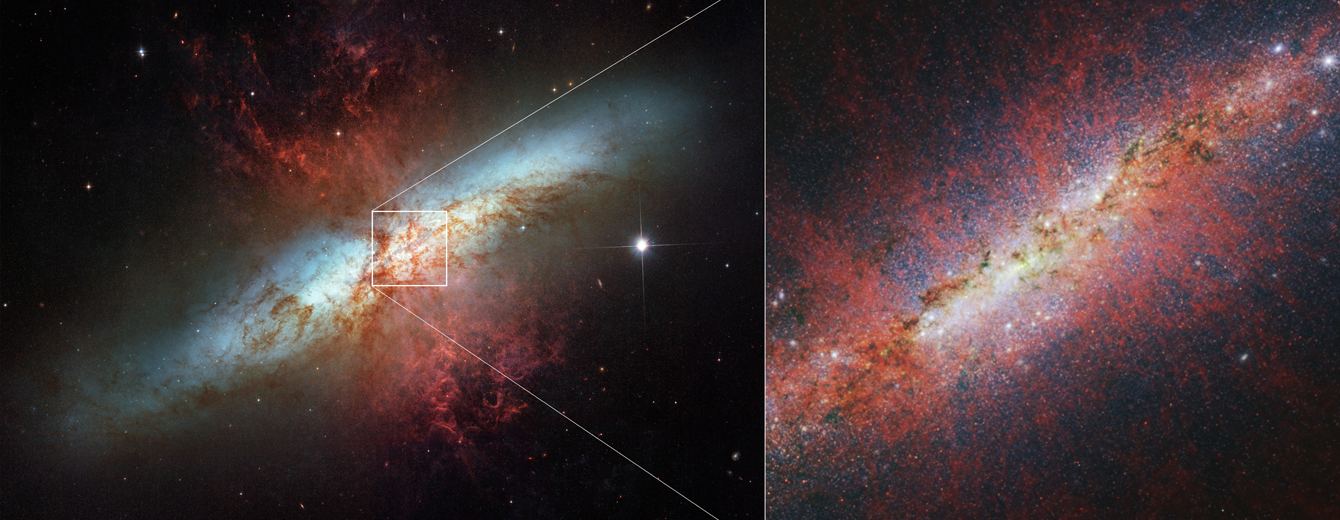Since it began operations in July 2022, the James Webb Space Telescope (JWST) has fulfilled many scientific objectives. In addition to probing the depths of the Universe in search of galaxies that formed shortly after the Big Bang, it has also provided the clearest and most detailed images of nearby galaxies. In the process, Webb has provided new insight into the processes through which galaxies form and evolve over billions of years. This includes galaxies like Messier 82 (M82), a “starburst galaxy” located about 12 million light-years away in the constellation Ursa Major.
Also known as the “Cigar Galaxy” because of its distinctive shape, M82 is a rather compact galaxy with a very high star formation rate. Roughly five times that of the Milky Way, this is why the core region of M82 is over 100 times as bright as the Milky Way’s. Combined with the gas and dust that naturally obscures visible light, this makes examining M82’s core region difficult. Using the extreme sensitivity of Webb‘s Near-Infrared Camera (NIRCam), a team led by the University of Maryland observed the central region of this starburst galaxy to examine the physical conditions that give rise to new stars.
The team was led by Alberto Bollato, an astronomy professor at the University of Maryland and a researcher with the Joint Space-Science Institute (JSSI). He was joined by researchers from NASA’s Jet Propulsion Laboratory, NASA Ames, the European Space Agency (ESA), the Space Telescope Science Institute (STScI), the ARC Centre of Excellence for All Sky Astrophysics in 3 Dimensions (ASTRO 3D), the Max-Planck-Institut für Astronomie (MPIA), National Radio Astronomy Observatory (NRAO), the Infrared Processing and Analysis Center (IPAC-Caltech) and multiple universities, institutes, and observatories. Their findings are described in a paper accepted for publication in The Astrophysical Journal.

Their observations were part of a Cycle 1 General Observations (GO) project – for which Bollato is the Principal Investigator (PI) – that used NIRCam data to examine the “prototypical starbursts” NGC 253 and M82 and their “cool” galactic winds. Such galaxies remain a source of fascination for astronomers because of what they can reveal about the birth of new stars in the early Universe. Starbursts are galaxies that experience rapid and efficient star formation, a phase that most galaxies went through during the early history of the Universe (ca. 10 billion years ago). Studying early galaxies in this phase is challenging due to the distances involved.
Fortunately, starburst galaxies like NGC 253 and M82 are relatively close to the Milky Way. While these galaxies have been observed before, Webb’s extreme sensitivity in the near-infrared spectrum provided the most detailed look to date. Moreover, the NIRCam observations were made using an instrument mode that prevented the galaxy’s intense brightness from overwhelming the instrument. The resulting images revealed details that have been historically obscured, such as dark brown tendrils of heavy dust that contained concentrations of iron (visible in the image as green specks).
These consist largely of supernova remnants, while small patches of red are clouds of molecular hydrogen lit up by young stars nearby. Said Rebecca Levy, second author of the study at the University of Arizona in Tucson, in a NASA press release, “This image shows the power of Webb. Every single white dot in this image is either a star or a star cluster. We can start to distinguish all of these tiny point sources, which enables us to acquire an accurate count of all the star clusters in this galaxy.”
Another key detail captured in the images is the “galactic wind” rushing out from the core, which was visible at longer infrared wavelengths. This wind is caused by the rapid rate of star formation and subsequent supernovae and has a significant influence on the surrounding environment. Studying this wind was a major objective of the project (GO 1701), which aimed to investigate how these winds interact with cold and hot material. By a central region of M82, the team was able to examine where the wind originates and the impact it has on surrounding material.

The team was surprised by the way Webb’s NIRCam was able to trace the structure of the galactic wind via emission spectra from very small dust grains known as polycyclic aromatic hydrocarbons (PAHs) – a chemical produced when coal, wood, gasoline, and tobacco are burned. These emissions highlighted the galactic wind’s fine structure, which appeared as red filaments flowing from above and below the galaxy’s disk. Another surprise was the structure of the PAH emission, which was similar to that of the hot ionized gas in the wind. As Bollato explained:
“M82 has garnered a variety of observations over the years because it can be considered as the prototypical starburst galaxy. Both NASA’s Spitzer and Hubble space telescopes have observed this target. With Webb’s size and resolution, we can look at this star-forming galaxy and see all of this beautiful, new detail. It was unexpected to see the PAH emission resemble ionized gas. PAHs are not supposed to live very long when exposed to such a strong radiation field, so perhaps they are being replenished all the time. It challenges our theories and shows us that further investigation is required.”
The team hopes to further investigate the questions these findings raise using Webb data, which will include spectroscopic observations made using the Near-infrared Spectrograph (NIRSpec) and large-scale images of the galaxy and wind. This data will help astronomers obtain accurate ages for the star clusters and determine how long each phase of star formation lasts in starburst galaxies. As always, this information could shed light on how similar phases took place in the early Universe, helping shape galaxies like ours. As Bollato summarized:
“Webb’s observation of M82, a target closer to us, is a reminder that the telescope excels at studying galaxies at all distances. In addition to looking at young, high-redshift galaxies, we can look at targets closer to home to gather insight into the processes that are happening here – events that also occurred in the early universe.”
Further Reading: Webb Space Telescope, MPIA

